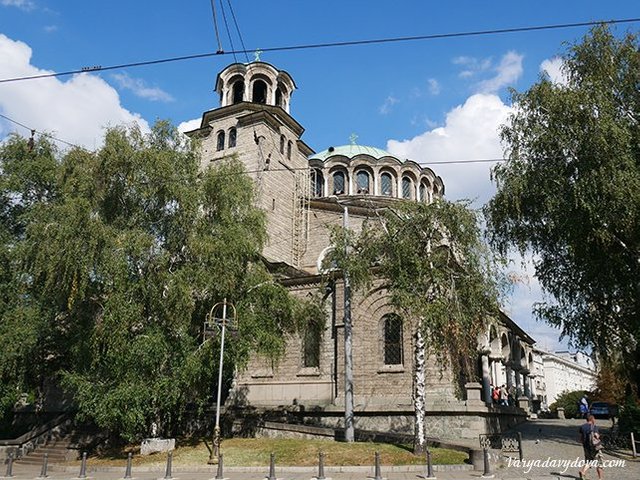Explosion in the church "Sveta Nedelya"
It was the bloodiest terrorist attack in the history of Bulgaria.
Church "Sveta Nedelya" is considered one of the most beautiful churches built during the Turkish rule in Bulgaria.

According to some of the Sofia residents who lived during the construction of this church, Sveta Nedelya turned out to be so big and beautiful, mostly thanks to Russia. This participation took place secretly through the Russian consul in Plovdiv, N. Gerov.

"Sveta Nedelya" is the cathedral church of the Sofia Metropolitanate. It stands in the very center of the capital on the square of the same name, which used to be called "Korucheshme", because there were mineral springs on it, and in antiquity, and Roman baths.

It is just on top of these baths that the current Church of Light of the Week is erected. More precisely, no one knows, but there are assumptions that the first temple on this site appeared approximately in the 10th century and existed until the middle of the 19th century.
In the early 50s of the 19th century, the Sofia Metropolitanate and the Sofia City Community decided to build a new cathedral, and in May 1856 the construction of a new church began.

It was a tricorb basilica 35.5 meters long and 19 meters wide - architect Ivan Boyanin.

In the fall of 1863, the construction was completed. Then the temple was painted for several years and illuminated in 1867. Under the provisional Russian government, in 1878, Prince Alexander Dondukov-Korsakov presented the temple with a set of bells - 8 pieces. Therefore, in 1879, a new bell tower was built, the old one was too small for them. In 1898, the architect Nikola Lazarov was involved in strengthening and decorating this church. Three domes were replaced by five. And in 1925 the church was destroyed by a violent explosion.

Atentat
This is what the Bulgarians call a terrorist attack.
On Maundy Thursday, April 16, 1925, members of the Military Organization of the Bulgarian Communist Party blew up the roof of the Church of Light of the Week in Sofia. At this time, a funeral ceremony for General Konstantin Georgiev was held in the church, especially for this (so that his funeral would serve as a bait) killed two days earlier at the service in the church of Cherna Jamia.
The purpose of this attack was an attempt on the life of Tsar Boris III (and the entire military-political elite), who was supposed to attend this ceremony, in their opinion. However, at that moment the king was in another church for another funeral service.

To carry out the operation, the conspirators brought 25 kg of explosives into the temple in advance. This was done with the help of Peter Zadgorski, who served in this church. The bomb was laid over one of the columns at the southern entrance under the very dome, from there a 15-meter fuse-cord descended. To enhance the damaging effect, a bottle of sulfuric acid was installed near the bomb.
On April 16 at 15:20 after a prearranged signal, one of the conspirators lit the fuse, and the main dome of the church collapsed on the people below. The fire commander said in his memoirs that he saw a "living tomb": pieces of icons, hats, hands, heads were covered in blood.

По разным сведениям в этом атентате погибло от 134 до 213 человек, некоторые умерли уже позже, раненых насчитали 500 душ.
Среди них было 12 генералов, 15 полковников, 7 подполковников, 3 майора, 9 капитанов и 3 депутата, а также просто солдаты и гражданские лица, включая детей.
Effects
Some of the organizers managed to escape to the neighboring Kingdom of Serbs, Croats and Slovenes and the Soviet Union, but Petr Zadgorski fell into the hands of the police and confessed everything. After that, most of the rest of the organization's members perished: they were killed during the arrest or committed suicide. The case of the terrorist attack was considered by a military court from May 1 to May 11. The most important of the accused, Marko Friedman, admitted that their organization received funding from the USSR through Vienna, but shifted responsibility to the dead participants, stating that they acted without approval. Despite this, he and the other participants received a death sentence, which was carried out on May 27.

On the evening of April 16, martial law was declared in the country until October 24. During this period, the government began to repress representatives of the extreme left flank. The Central Committee of the BKP officially declared its disapproval of such an act and renounced it. Later, under socialism, the BCP emphasized in every possible way that this act of terrorism was committed by "leftist sectarians" who acted against the will of the party.
Recovery

The renovation of the blown-up church began in June 1927, and by the spring of 1933 an almost new central-domed church was erected, 30 meters long and 15.5 meters wide. The height of the dome is 31 m. Three more bells were added to the bell tower: in addition to the eight donated by Dondukov, two bells made in Serbia and one more, cast in Bulgaria, were hung there. The murals were made in the period 1971-1973.

Thank you for your time and attention.
Follow me for more content to come!
With love from Bulgaria @varya-davydova
Chronicles of the Bulgarian coronavirus: https://t.me/varyadavydovabg